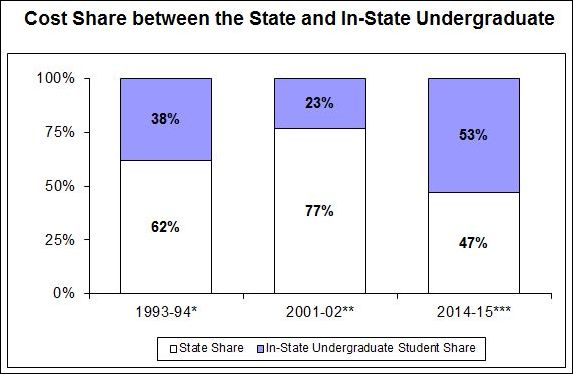By Steve Haner
I don’t know about others, but I notified the Governor’s Office in March that I did not want another term on the State Council for Higher Education in Virginia (SCHEV). My goal in going on that panel was to advocate against skyrocketing tuition. Four years of a losing battle was enough.
The Richmond Times-Dispatch reported recently that incoming in-state freshmen at William and Mary will pay $30,350 a year, or $121,400 over four years, with room and board included. The “affordably accessible” University of Virginia will soon catch up. In both cases some of the increased tuition revenue is openly diverted to scholarships for others. How much remains to be seen.
In a presentation on “affordable excellence” to the General Assembly last month, the president of UVA argued that only 30 percent of Virginia families will be classified as so wealthy they have to pay this new top tuition price. That is not the question – the question is how many of the families of high school graduates entering UVA will have to pay it? That may be far higher than 30 percent. How many families will find that years of saving for college means they end up paying the higher price?
The economic incentive for both UVA and W&M will be to take in more and more students paying full freight. The economic incentive will be to limit the number of students accepted who need financial aid. Having moved this far without objection, I fear they will go further – seeking tuitions equal to the private schools they consider their competition.
The General Assembly may be accepting the new “from each according to his means” pricing structures at UVA and William and Mary because it is removes pressure to fund the alternative. As recently as 2011, in the so-called “Top Jobs of the 21st Century” legislation, the Assembly reaffirmed its commitment to funding 67 percent of the cost of an undergraduate program for in-state students. And the year before the state came very close to that, funding 62 percent overall.
The four years that followed were a period of erosion in state funds and tuitions rising far faster than inflation. In the school term ending in the spring of 2014, according to data I asked State Council for Higher Education in Virginia to compile, Virginia had crossed the Rubicon. The percentage of the cost of higher education for in-state undergraduates covered by the state fell to below 50 percent. In the school term just completed, it dropped another couple of points to 47 percent. Even at the low cost community colleges, the gateway schools, the state now covers less than half.
Tuition increases have made up the difference. From 2010 to 2014 the basic general fund account for the state schools started and ended at $1.3 billion (with a dip in between), which means due to inflation it lost value. From 2010 to 2014 non-general fund revenue (mostly tuition and fees) rose from $2.2 to $2.8 billion, an additional $600 million a year. Much of that money had to be borrowed by families. And those figures do not reflect what William and Mary and UVA are now doing. That will be fully reflected in future reports.
In the most recently adopted state budget there is a slight uptick in general funds for the schools for 2015-16. But two schools are receiving less support in 2015 than in 2010. Guess which two. The question now is how soon will Virginia Tech, James Madison or George Mason adopt the same pricing policy? Will they be forced to even if they would rather not?
This is a sea change in Virginia’s system of public higher education. I’m sure this will be popular with Virginia taxpayers (and voters) who feel they have no stake in the public institutions and thus resent paying taxes to support them. But it deserves more debate and discussion than it is getting, because I cannot see how raising the price of getting educated is going to result in a more educated populace.



